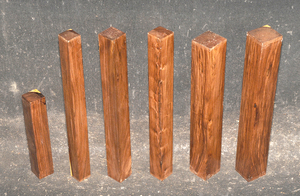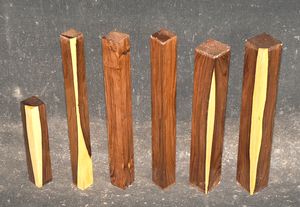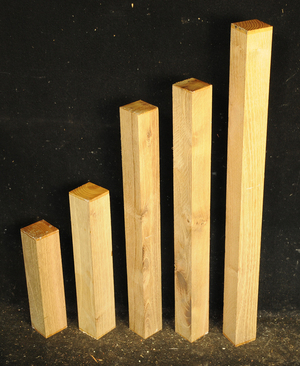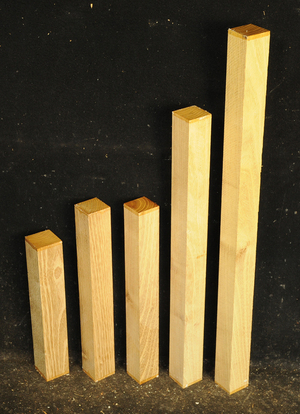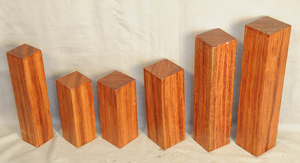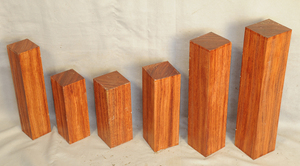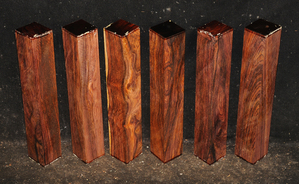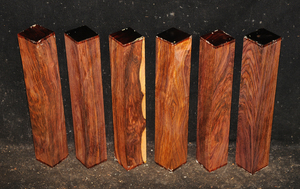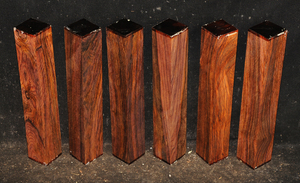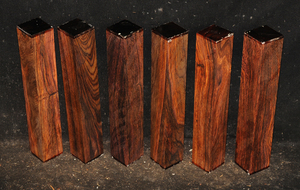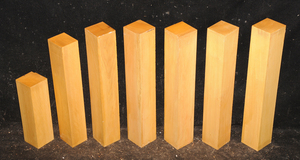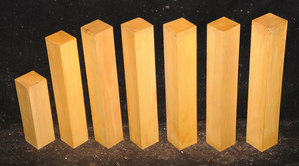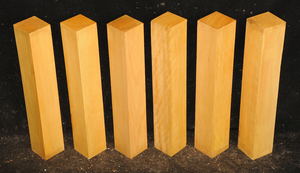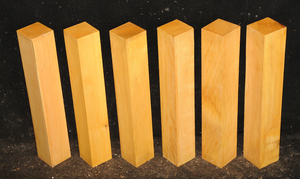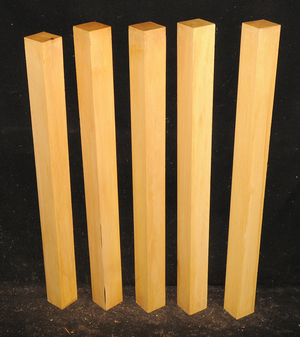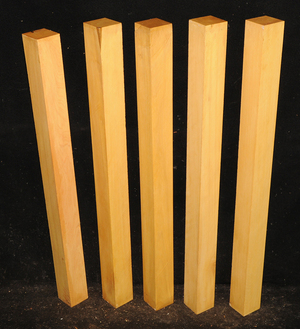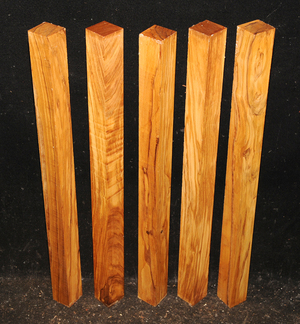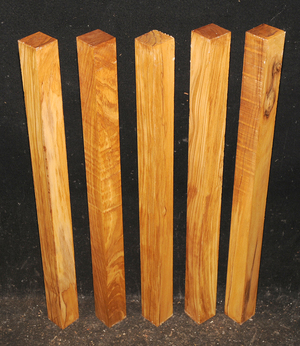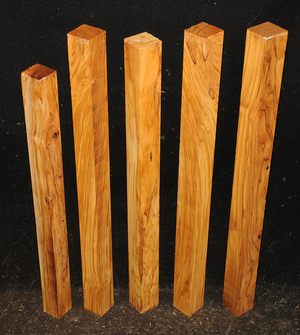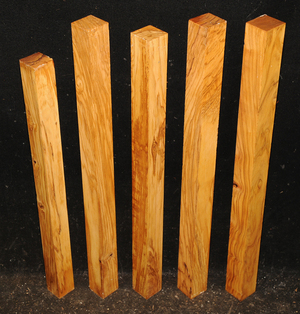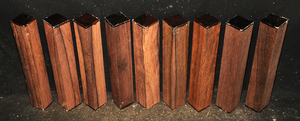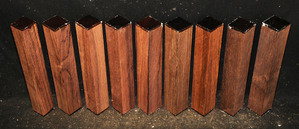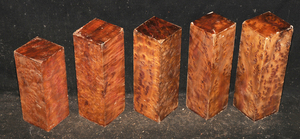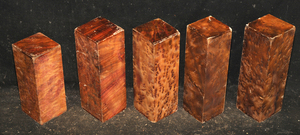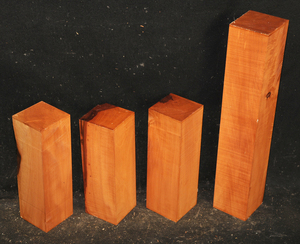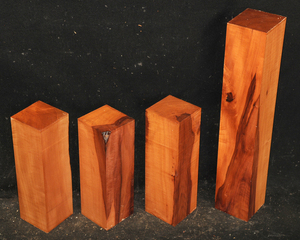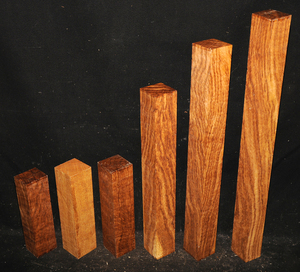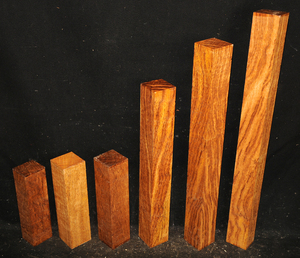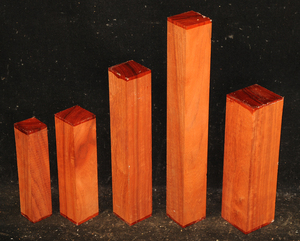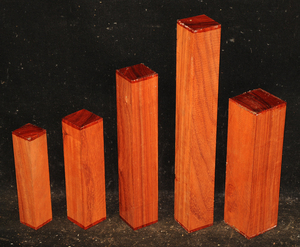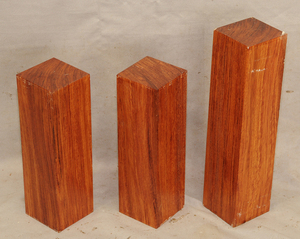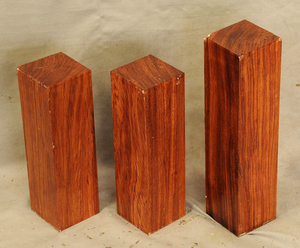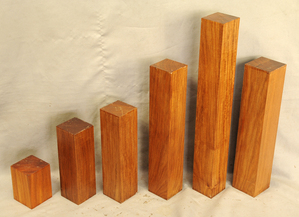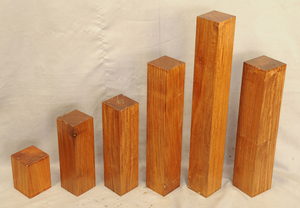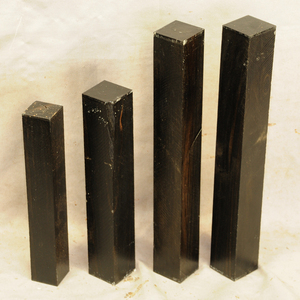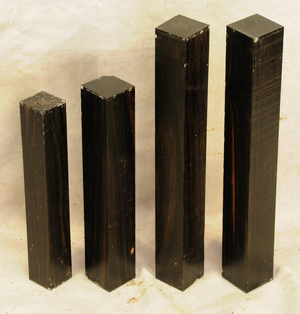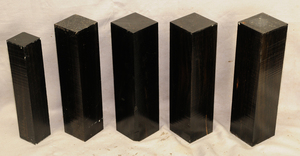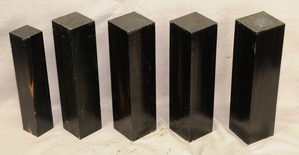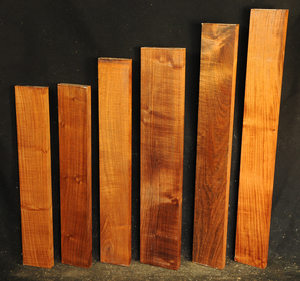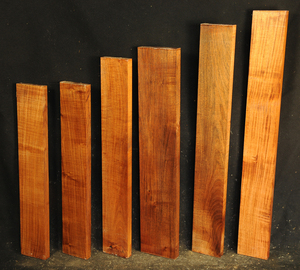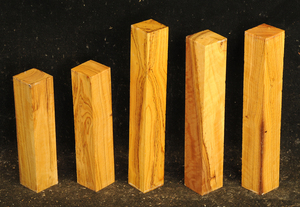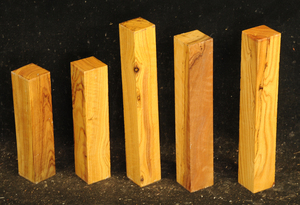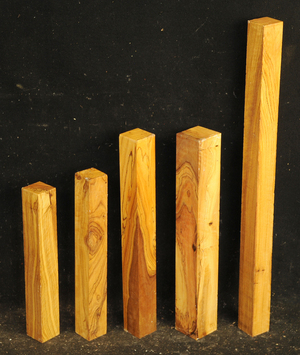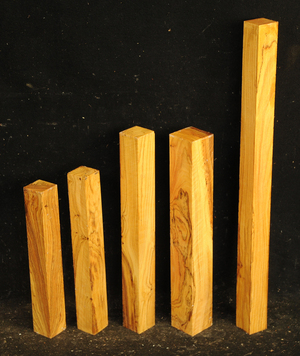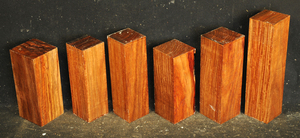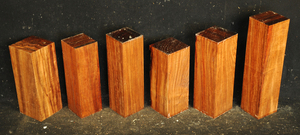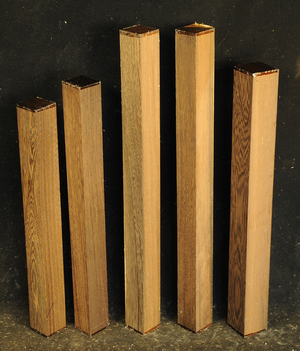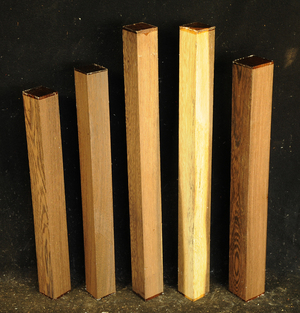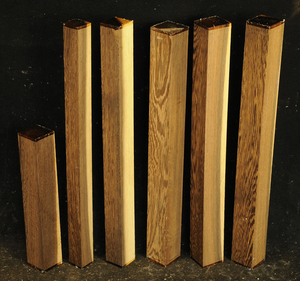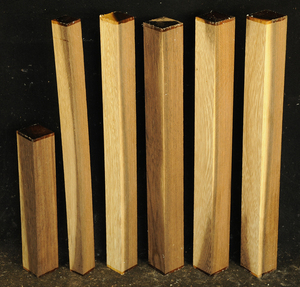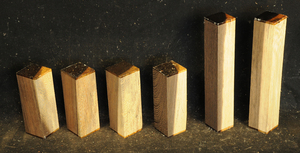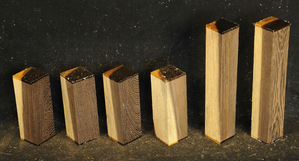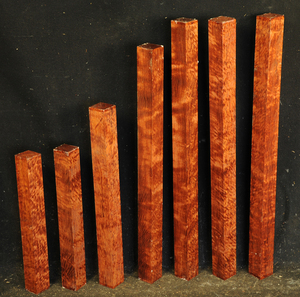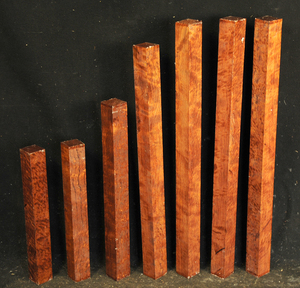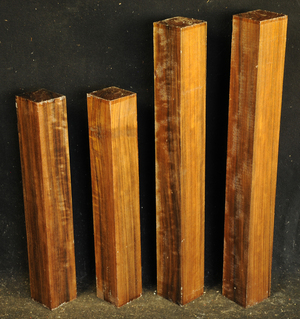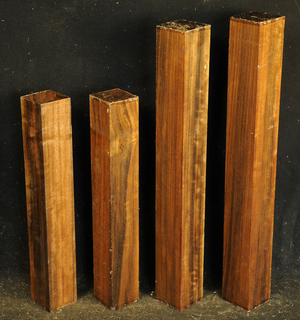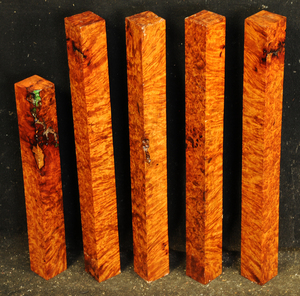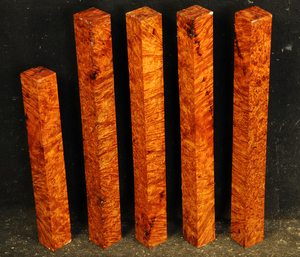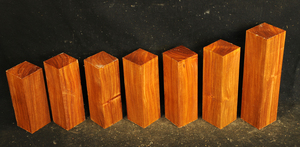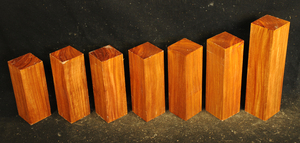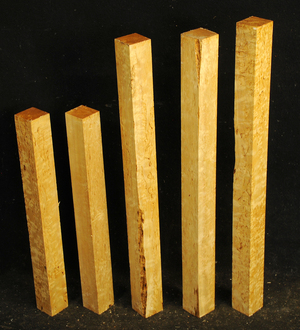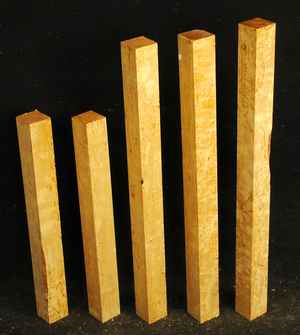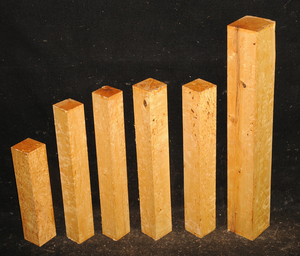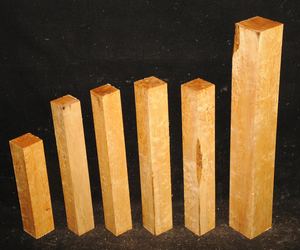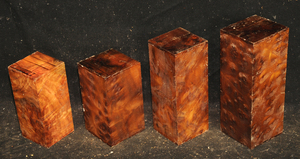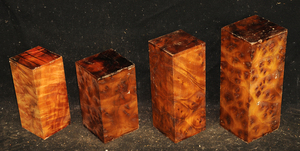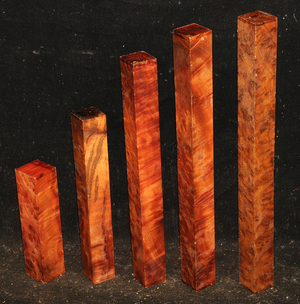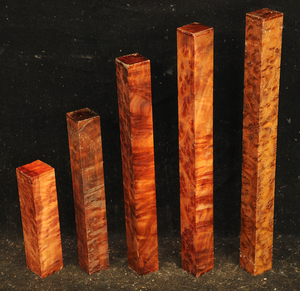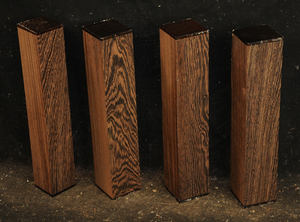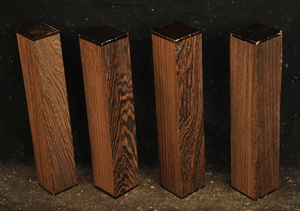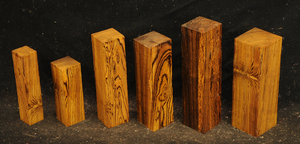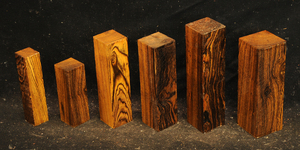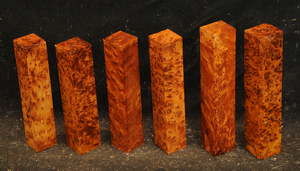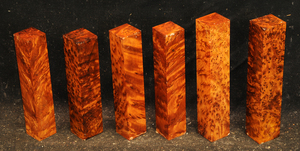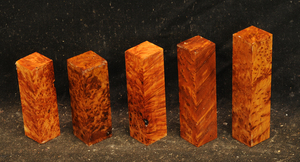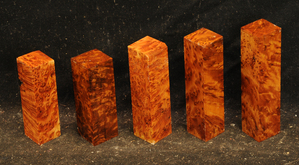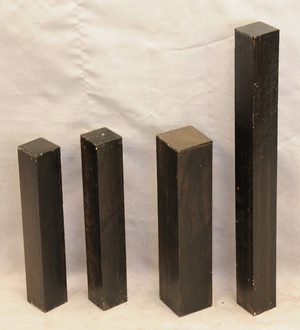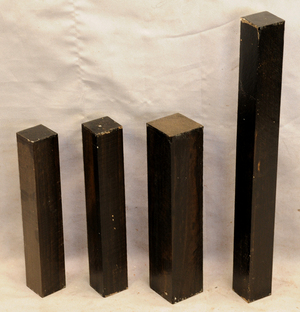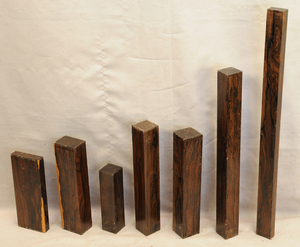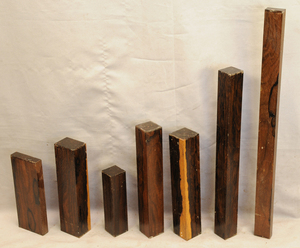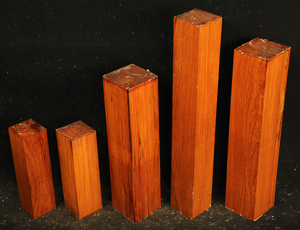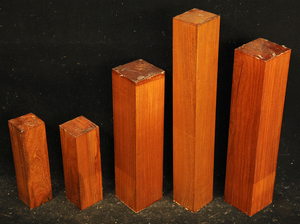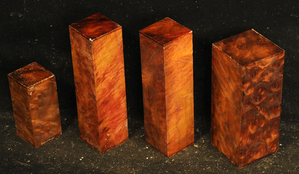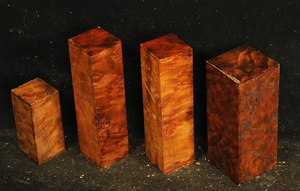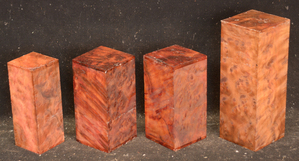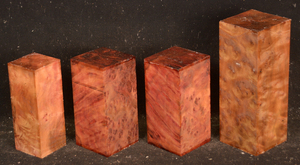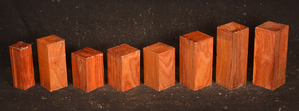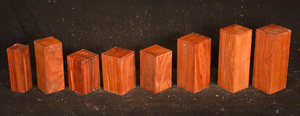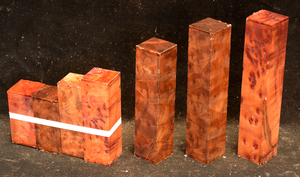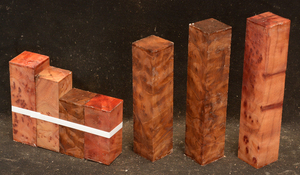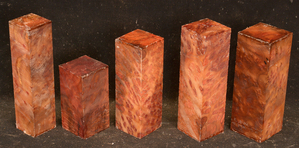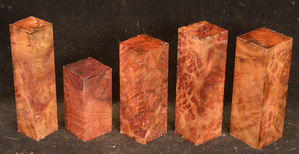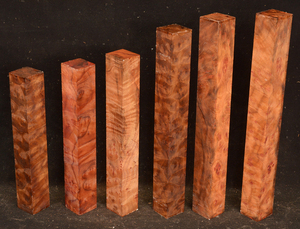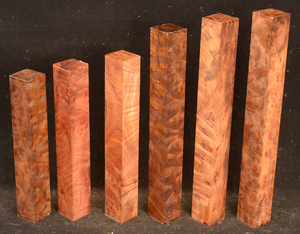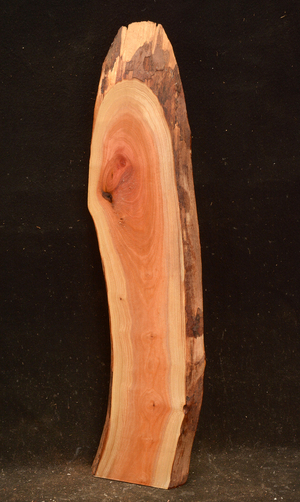Cocuswood Turning Squares
Brya ebenus
This extremely rare species is found in Cuba, Jamaica, and the Dominican Republic. Also called Green, Brown, or West Indian Ebony. The heartwood is brownish-yellow to dark brown often with a greenish tinge. It is usually beautifully veined with darker streaks. The wood is hard and heavy weighing 68 to 80 lbs/cubic foot. This high density contributes to its wonderful acoustic properties-it fairly rings when struck. It is well known for its use in woodwinds such as flutes, piccolos, and bagpipes because of its fine and uniform grain, its beautiful coloring and its resonance.
C the actual length is 12 but we tallied it at 8 3/8 because of slight defects on one end.
F has a small defect on 2 corners that looks to go through the middle of the square.. You will for sure get 2 pieces that are clear that are 4 1/4" and 6 1/2" long. The actual length is 11 11/16". Priced according to the clear sections.
Item Number: W43609
Black Locust Turning Squares
Item Number: W43598
Black Locust Turning Squares
Item Number: W43597
Bubinga Turning Squares
Guibourtia tessmannii
Called by some woodworkers African Rosewood, Bubinga is a deep, lustrous, brownish-red color with a fine, darker striping. The figure makes the wood doubly beautiful. It is very hard and heavy and takes a glassy, smooth finish.
Due to CITES regulations, we can only ship this species to customers in the United States.
Item Number: W43596
Mexican Cocobolo Turning Squares
Dalbergia retusa
The wood is very oily which makes it difficult to glue but on the plus side the oiliness makes it easy to produce a fantastic polish on finished pieces. Wear a respirator mask when working Cocobolo as the dust can produce asthma-like reactions. Cocobolo is a small to medium sized tree and is found mainly in Mexico, Costa Rica, Nicaragua, and Panama.
Due to CITES regulations, we can only ship this species to customers in the United States.
Item Number: W43592
Mexican Cocobolo Turning Squares
Dalbergia retusa
The wood is very oily which makes it difficult to glue but on the plus side the oiliness makes it easy to produce a fantastic polish on finished pieces. Wear a respirator mask when working Cocobolo as the dust can produce asthma-like reactions. Cocobolo is a small to medium sized tree and is found mainly in Mexico, Costa Rica, Nicaragua, and Panama.
Due to CITES regulations, we can only ship this species to customers in the United States.
Item Number: W43591
Castello Boxwood Turning Squares
Calycophyllum multiflorum
Castello Boxwood, though not a true Buxus species, still has a very fine texture and a lovely light canary yellow color. This is truly a dream wood to mill.It is an excellent turnery wood, capable of very fine detail. Also very popular for making scale timbers and other parts for model ships. Air-dried.
Item Number: W43590
Castello Boxwood Turning Squares
Calycophyllum multiflorum
Castello Boxwood, though not a true Buxus species, still has a very fine texture and a lovely light canary yellow color. This is truly a dream wood to mill.It is an excellent turnery wood, capable of very fine detail. Also very popular for making scale timbers and other parts for model ships. Air-dried.
Item Number: W43589
Castello Boxwood Turning Squares
Calycophyllum multiflorum
Castello Boxwood, though not a true Buxus species, still has a very fine texture and a lovely light canary yellow color. This is truly a dream wood to mill.It is an excellent turnery wood, capable of very fine detail. Also very popular for making scale timbers and other parts for model ships. Air-dried.
Item Number: W43588
Mediterranean Olivewood Turning Squares
Olea europa
A wood of biblical importance, no wood is more closely associated with history and the development of civilization than Olivewood. A beautifully variegated timber. Partially air-dried.
B is figured.
Item Number: W43575
Mediterranean Olivewood Turning Squares
Olea europa
A wood of biblical importance, no wood is more closely associated with history and the development of civilization than Olivewood. A beautifully variegated timber. Partially air-dried.
A has some small, loose knots.
Item Number: W43574
Palisander Turning Squares
Dalbergia baronii
One of several rosewood species from Madagascar. It has beautiful color and grain, a sweet smell, and is very easy to work and stable in use. It is a very close match to true Rio or Brazilian Rosewood (Dalbergia nigra) and as such is much in demand for musical instruments, especially guitars.
Due to this item being on the CITES list, we are only shipping this species to addresses in the United States.
Item Number: W43573
Camphor Burl Turning Squares
Cinnamomum sp.
This rare burl is from S.E. Asia and is seldom seen on the world market. It is fine-grained and varies in color from a light reddish-brown to almost scarlet. It is easy to work and has a very pungent, spicy scent. For a burl it is remarkably stable. Green to partially air dried.
Item Number: W43568
European Pearwood Turning Squares
Pyrus communis
Almost all Pearwood imported into the U.S.A. has been steamed to bring out a more pinkish-red color and to prevent drying stresses. Formerly the wood was used for carving, turning, drawing instruments, wood engravings, textile printing blocks, and tool handles. Stained black it is an excellent substitute for Ebony. Contemporary uses include woodwinds such as recorders, furniture, kitchen accessories, jewelry and other boxes, and architectural uses such as paneling and doors.
Item Number: W43563
English Brown Oak Turning Squares
Quercus robur
This wood takes a beautiful polish and develops a rich, warm patina.Typical voids and defects as well as the occasional small pin holes.
Some of these aren't quite squares.
Item Number: W43560
Padouk Turning Squares
Pterocarpus soyauxii
This brick-red colored West African hardwood was once one of the more common imported hardwoods but has become increasingly scarce in the last couple of years. It is easy to work, takes a nice polish and is dimensionally stable.
Item Number: W43546
Bubinga Turning Squares
Guibourtia tessmannii
Called by some woodworkers African Rosewood, Bubinga is a deep, lustrous, brownish-red color with a fine, darker striping. The figure makes the wood doubly beautiful. It is very hard and heavy and takes a glassy, smooth finish.
Due to CITES regulations, we can only ship this species to customers in the United States.
Item Number: W43545
Narra Turning Squares
Pterocarpus indicus
Also called New Guinea Rosewood. It is a beautiful, highly lustrous golden yellow color sometimes with reddish streaks. A nice turning wood it is also used in furniture, jewelry boxes, handles, etc. It is easy to work and glue and takes a nice polish.
Item Number: W43544
West African Ebony Turning Squares
Diospyros crassiflora
Sometimes called Gabon or Gaboon, this Ebony is sometimes jet black but oftentimes has grayish streaks that mostly disappear when finished or after the made object has been put into service. This Ebony has a marked resistance to checking that is characteristic of some of the Indian and Asian species. It has a wonderful texture and is easily carved, planed, turned, and milled. It is fairly fine-grained and takes a high polish. This Ebony usually originates in either Cameroon or Nigeria and the logs are rough hewn in the forest and oftentimes brought to the nearest road by human porters. With the disappearance of other species of black Ebony this species is fast becoming the Ebony of choice.
Item Number: W43537
West African Ebony Turning Squares
Diospyros crassiflora
Sometimes called Gabon or Gaboon, this Ebony is sometimes jet black but oftentimes has grayish streaks that mostly disappear when finished or after the made object has been put into service. This Ebony has a marked resistance to checking that is characteristic of some of the Indian and Asian species. It has a wonderful texture and is easily carved, planed, turned, and milled. It is fairly fine-grained and takes a high polish. This Ebony usually originates in either Cameroon or Nigeria and the logs are rough hewn in the forest and oftentimes brought to the nearest road by human porters. With the disappearance of other species of black Ebony this species is fast becoming the Ebony of choice.
Item Number: W43536
Figured Black Mesquite
Prosopis nigra
A very few pieces of Mesquite are figured with what we call frog's-hair curl, a small, tight curl with as many as 12-15 curls per inch. A very stable wood. Air-dried.
Item Number: W43518
African Wild Olivewood Turning Squares
Olea macrocarpa
A species of Olive from South Africa. Very rarely seen on the commercial timber market. It is similar in color to the European species but is denser and harder with more variegations of color and grain. Partially air-dried.
Item Number: W43509
African Wild Olivewood Turning Squares
Olea macrocarpa
A species of Olive from South Africa. Very rarely seen on the commercial timber market. It is similar in color to the European species but is denser and harder with more variegations of color and grain. Partially air-dried.
Item Number: W43508
Figured Narra Turning Squares
Pterocarpus indicus
Also called New Guinea Rosewood. It is a beautiful, highly lustrous golden yellow color sometimes with reddish streaks. A nice turning wood it is also used in furniture, jewelry boxes, handles, etc. It is easy to work and glue and takes a nice polish.
Item Number: W43501
Panga Panga Turning Squares
Millettia Stuhlmannii
This Cental African tree is scarce on the American market. It has a similar apperance to its close relative, Wenge. Hard and heavy with a medium to coarse texture, it can have some porousness to the grain.
Panga Panga was popular in the early 1990's when Wenge all but disappeared because of supply problems in the Congo basin. It makes beautiful furniture, turnings, and precious boxes, having a deep, dark chocolate brown color once finished, though still a little lighter in color than Wenge.
Item Number: W43495
Panga Panga Turning Squares
Millettia Stuhlmannii
This Cental African tree is scarce on the American market. It has a similar apperance to its close relative, Wenge. Hard and heavy with a medium to coarse texture, it can have some porousness to the grain.
Panga Panga was popular in the early 1990's when Wenge all but disappeared because of supply problems in the Congo basin. It makes beautiful furniture, turnings, and precious boxes, having a deep, dark chocolate brown color once finished, though still a little lighter in color than Wenge.
Item Number: W43494
Panga Panga Turning Squares
Millettia Stuhlmannii
This Cental African tree is scarce on the American market. It has a similar apperance to its close relative, Wenge. Hard and heavy with a medium to coarse texture, it can have some porousness to the grain.
Panga Panga was popular in the early 1990's when Wenge all but disappeared because of supply problems in the Congo basin. It makes beautiful furniture, turnings, and precious boxes, having a deep, dark chocolate brown color once finished, though still a little lighter in color than Wenge.
Item Number: W43490
Pomelle Bubinga Turning Squares/Pool Cue Blanks
Guibourtia tessmannii
Called by some woodworkers African Rosewood, Bubinga is a deep, lustrous, brownish-red color with a fine, darker striping. This small blister figure is the rarest figure found in Bubinga.
Due to CITES regulations, we can only ship this species to customers in the United States.
Item Number: W43478
Figured Shedua Turning Squares
Guibourtia sp.
Also called Ovangkol and Amazakoue. This wood is increasingly becoming popular as an acoustic guitar wood. The color varies from a rich, golden brown to a lustrous grayish brown usually with a black stripe.
Item Number: W43476
Amboyna Burl Turning Squares/Pool Cue Blanks
Pterocarpus indicus
One of the world's most rare and beautiful burls. A light to deep reddish-orange, sometimes with darker lines, and with a lovely, spicy scent, there is hardly an area not highly figured with bird's-eyes. Hard & heavy and capable of taking a fine polish.
A is only tallied at 9" long due to some defects at one end.
B is only tallied at 14 1/4" due to a defects at one end.
Item Number: W43471
Narra Turning Squares
Pterocarpus indicus
Also called New Guinea Rosewood. It is a beautiful, highly lustrous golden yellow color sometimes with reddish streaks. A nice turning wood it is also used in furniture, jewelry boxes, handles, etc. It is easy to work and glue and takes a nice polish.
Item Number: W43467
Masur Birch Turning Squares
Betula alba
Also called Alpine Burl or Karelian Burl after the Finnish province of Karelia where it is often found. The high figure found in this wood is caused when the tree heals the damage done by an invasive boring beetle. The beetle infestation leaves the trees stunted and sometimes deformed but produces wood with small twists and swirls that highlight the darker, burly figure. Rare.
Item Number: W43462
Masur Birch Turning Squares
Betula alba
Also called Alpine Burl or Karelian Burl after the Finnish province of Karelia where it is often found. The high figure found in this wood is caused when the tree heals the damage done by an invasive boring beetle. The beetle infestation leaves the trees stunted and sometimes deformed but produces wood with small twists and swirls that highlight the darker, burly figure. Rare.
Item Number: W43461
Camphor Burl Turning Squares
Cinnamomum sp.
This rare burl is from S.E. Asia and is seldom seen on the world market. It is fine-grained and varies in color from a light reddish-brown to almost scarlet. It is easy to work and has a very pungent, spicy scent. For a burl it is remarkably stable. Green to partially air dried.
Item Number: W43451
Camphor Burl Turning Squares
Cinnamomum sp.
This rare burl is from S.E. Asia and is seldom seen on the world market. It is fine-grained and varies in color from a light reddish-brown to almost scarlet. It is easy to work and has a very pungent, spicy scent. For a burl it is remarkably stable. Green to partially air dried.
Item Number: W43449
Wenge Turning Squares
Millettia laurentii
Most Wenge comes from the interior of the Democratic Republic of the Congo (formerly Zaire), and is floated to market on the Congo river. It is fairly hard and heavy with a medium to coarse texture. The heartwood is very dark brown with fine, nearly parallel black veining. Very rich looking when finished.
Item Number: W43430
Mexican Bocote Turning Squares
Cordia elaeagnoides
Bocote is an oily wood with a yellowish to dark brown color accented with irregular black stripes and streaks. It has a spicy smell and is hard, heavy and strong. It is easy to work and takes a very nice polish. This beautiful wood is seldom seen in woodworker's shops.
Item Number: W43427
Thuya Burl Turning Squares
Tetraclinis articulata
This comes from the Atlas mountains in Morocco and has a beautiful golden chatoyance. Its color varies from a rich, lustrous golden brown to nearly black. Thuya burl is hard and dense with a high oil content, but tends to be brittle. The eyes, perfectly round, are scattered about in some burls like the figure in bird's-eye maple; in others they are grouped as islands. Due to it's desert occurrence, the wood sometimes contains small defects or inclusions but most can be repaired with cyanoacrylate (super) glues. A rare species, this exquisite wood is used for inlays, small boxes, turnery, and precious objects.
Item Number: W43425
Thuya Burl Turning Squares
Tetraclinis articulata
This comes from the Atlas mountains in Morocco and has a beautiful golden chatoyance. Its color varies from a rich, lustrous golden brown to nearly black. Thuya burl is hard and dense with a high oil content, but tends to be brittle. The eyes, perfectly round, are scattered about in some burls like the figure in bird's-eye maple; in others they are grouped as islands. Due to it's desert occurrence, the wood sometimes contains small defects or inclusions but most can be repaired with cyanoacrylate (super) glues. A rare species, this exquisite wood is used for inlays, small boxes, turnery, and precious objects.
Item Number: W43424
West African Ebony Turning Squares
Diospyros crassiflora
Sometimes called Gabon or Gaboon, this Ebony is sometimes jet black but oftentimes has grayish streaks that mostly disappear when finished or after the made object has been put into service. This Ebony has a marked resistance to checking that is characteristic of some of the Indian and Asian species. It has a wonderful texture and is easily carved, planed, turned, and milled. It is fairly fine-grained and takes a high polish. This Ebony usually originates in either Cameroon or Nigeria and the logs are rough hewn in the forest and oftentimes brought to the nearest road by human porters. With the disappearance of other species of black Ebony this species is fast becoming the Ebony of choice.
Item Number: W43420
Ziricote
Cordia dodecandra
Ziricote is another timber we get from the Yucatan Peninsula of Mexico. It is a lovely wood with a very pronounced ray fleck on radial surfaces sometimes producing a "landscape" effect much like picture jasper.
Item Number: W43415
Pau Rosa Turning Squares
Swartzia fistuloides
Hard & heavy & capable of a beautiful polish. Rare on the American market. Partially air dried.
Item Number: W43398
Camphor Burl Turning Squares
Cinnamomum sp.
This rare burl is from S.E. Asia and is seldom seen on the world market. It is fine-grained and varies in color from a light reddish-brown to almost scarlet. It is easy to work and has a very pungent, spicy scent. For a burl it is remarkably stable. Green to partially air dried.
Item Number: W43393
Camphor Burl Turning Squares
Cinnamomum sp.
This rare burl is from S.E. Asia and is seldom seen on the world market. It is fine-grained and varies in color from a light reddish-brown to almost scarlet. It is easy to work and has a very pungent, spicy scent. For a burl it is remarkably stable. Green to partially air dried.
Item Number: W43370
Pau Rosa Turning Squares
Swartzia fistuloides
Hard & heavy & capable of a beautiful polish. Rare on the American market. Partially air dried.
Item Number: W43365
Camphor Burl Bundle & Turning Squares
Cinnamomum sp.
This rare burl is from S.E. Asia and is seldom seen on the world market. It is fine-grained and varies in color from a light reddish-brown to almost scarlet. It is easy to work and has a very pungent, spicy scent. For a burl it is remarkably stable. Green to partially air dried.
A has 4 pieces.
Item Number: W43342
Camphor Burl Turning Squares
Cinnamomum sp.
This rare burl is from S.E. Asia and is seldom seen on the world market. It is fine-grained and varies in color from a light reddish-brown to almost scarlet. It is easy to work and has a very pungent, spicy scent. For a burl it is remarkably stable. Green to partially air dried.
Item Number: W43341
Camphor Burl Turning Squares
Cinnamomum sp.
This rare burl is from S.E. Asia and is seldom seen on the world market. It is fine-grained and varies in color from a light reddish-brown to almost scarlet. It is easy to work and has a very pungent, spicy scent. For a burl it is remarkably stable. Green to partially air dried.
Item Number: W43340
Pink Ivory
Berchemia zeyheri
A fairly rare wood from Southern Africa ranging in color from light pink to watermelon red. At one time it was described as being "rarer than diamonds". It is very dense, hard and heavy and takes a very high polish. Beautiful for turnery, inlays and other precious items.
This piece has a couple cracks in the middle of one face and a small inclusion on the same face. These defects don't go through to the other side.
Item Number: W43336
Figured Castello Boxwood Turning Squares
Calycophyllum multiflorum
Castello Boxwood, though not a true Buxus species, still has a very fine texture and a lovely light canary yellow color. This is truly a dream wood to mill.It is an excellent turnery wood, capable of very fine detail. Also very popular for making scale timbers and other parts for model ships. Air-dried.
Item Number: W43293

